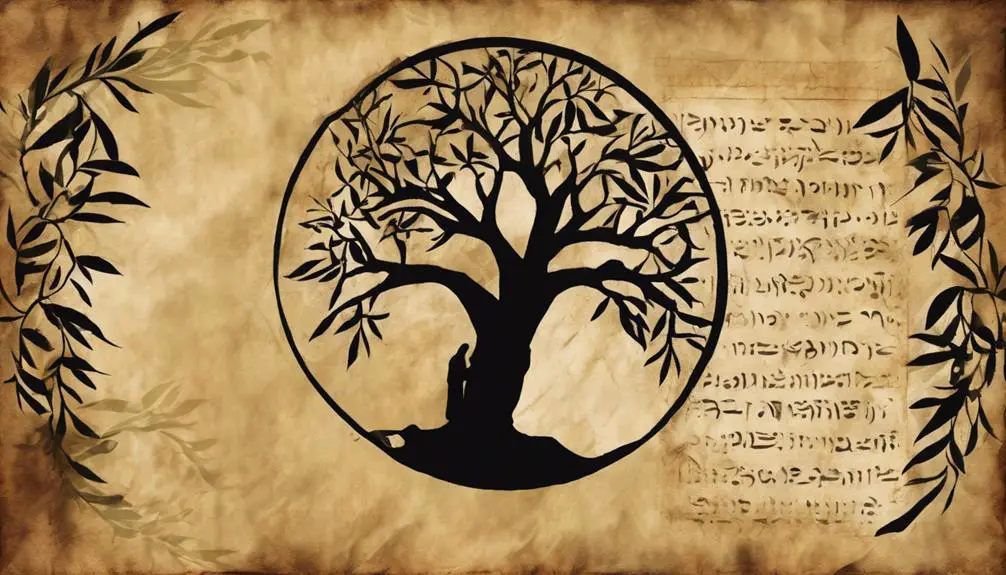Kneel into the biblical tales of lunacy, where ancient beliefs and divine interventions entwine, inviting a deeper understanding of spirituality and mental health.

Lunatic in the Bible
You might not be aware that the term 'lunatic' has a fascinating origin and even finds its way into biblical scripture, encompassing a range of conditions that today would likely be understood quite differently.
The Bible's depiction of lunacy, often intertwined with spiritual and demonic narratives, offers a unique lens through which to view ancient attitudes towards mental health and illness.
As we explore biblical accounts of lunacy, their implications for healing and compassion, and how these perspectives have evolved—or perhaps not—into contemporary society's understanding, you'll uncover layers of meaning that might change how you interpret these ancient texts and their relevance today.
Key Takeaways
- The term 'lunatic' in the Bible reflects ancient beliefs about the moon's influence on mental health.
- Biblical narratives often attribute mental illness to supernatural forces, emphasizing miraculous healing.
- Interpretations of 'lunatic' have evolved, inviting a modern exploration of mental health through a spiritual lens.
- Shifts in language and understanding underscore the importance of empathy and compassion in addressing mental health today.
Definition and Origins

The term 'lunatic' in the Bible, originating from the Latin word 'lunaticus,' literally means 'moonstruck' and reflects ancient beliefs about the moon's influence on mental health. This concept showcases the intertwining of language evolution and cultural perceptions over centuries. As societies advanced, the understanding of mental health evolved, yet the linguistic imprint of these early beliefs persisted.
Analyzing the term's etymology provides insight into how ancient cultures attributed certain mental health conditions to celestial phenomena. It's a testament to the power of language in shaping, and also preserving, societal understandings and misconceptions. The progression from 'lunaticus' to 'lunatic' in English illustrates not just a phonetic transformation but a shift in the collective consciousness regarding mental health.
Furthermore, the integration of such terms into religious texts like the Bible underlines the significant role religion played in framing cultural perceptions of mental illness. It's crucial to acknowledge the historical context in which these terms were used to appreciate the depth of their impact on contemporary language and attitudes toward mental health. This linguistic journey from 'moonstruck' to 'lunatic' encapsulates a broader narrative of human attempts to comprehend and categorize the complexities of mental wellbeing.
Biblical Accounts of Lunacy

In exploring biblical accounts of lunacy, it's essential to consider how these narratives reflect the period's understanding of mental health and its attributed causes. The term 'lunacy' itself, often linked to 'moon madness,' suggests a connection between mental disturbances and the lunar phases, a belief widespread in ancient times.
- Moon Madness: Ancient texts, including the Bible, hint at a belief in the influence of celestial bodies on human behavior. While not explicitly stated, the term 'lunatic' in biblical contexts implies a link between the moon and erratic behavior.
- Demon Possession: The Bible frequently attributes mental illness to demonic forces. This perspective was common, reflecting a supernatural interpretation of what we might today classify under mental health disorders.
- Cultural Interpretations: These accounts offer insight into how ancient societies perceived mental illness, often through a lens of spiritual or cosmic influence rather than medical understanding.
- Literary Depictions: Biblical narratives depicting lunacy, therefore, must be analyzed within their historical and cultural contexts, recognizing that these stories convey the period's attitudes towards mental health and its causes.
Healing and Compassion

Reflecting on historical interpretations of lunacy, it's crucial to explore biblical portrayals of healing and compassion within these narratives. The Bible frequently presents instances where individuals considered lunatic or possessed by demons experience miraculous interventions, underscoring a profound message of spiritual resilience and divine compassion. These stories aren't just about the physical healing of individuals but also about the restoration of their dignity and place within their communities.
In analyzing these accounts, you'll notice that the healers, often figures of divine authority or proxies thereof, approach the afflicted with a deep sense of empathy and a desire to restore wholeness. This compassionate response is pivotal, as it not only facilitates physical healing but also rekindles hope and faith among the afflicted and their observers.
Miraculous interventions in these stories serve as a testament to the power of faith and the importance of compassion in the healing process. The narratives emphasize that healing isn't merely a physical act but involves spiritual resilience, community reintegration, and the reaffirmation of the individual's worth. Through these biblical accounts, the enduring message is clear: compassion and understanding are essential components of healing and restoration.
Societal Attitudes Then and Now

Historical and contemporary societal attitudes towards lunacy reveal a profound shift from fear and marginalization to a growing understanding and empathy. Initially, cultural stigma heavily influenced perceptions, leading to isolation and often cruel historical treatments of those deemed lunatic. Over time, however, awareness and compassion have gradually taken precedence, reshaping societal views.
- Cultural Stigma: Historically, lunacy was often seen through a lens of fear and superstition, leading to significant social stigma. Individuals were marginalized, facing not just societal rejection but also often severe mistreatment.
- Historical Treatments: Treatment methods ranged from the barbaric to the simply ineffective, reflecting a profound misunderstanding of mental illness. Practices such as exorcisms, confinement, and even physical harm were common, underlining a lack of empathy and understanding.
- Shift in Understanding: The transition towards a more empathetic approach began with the enlightenment, as scientific and psychological insights started to challenge prevailing superstitions and biases.
- Contemporary Empathy: Today, there's a growing emphasis on mental health awareness and treatment, reflecting a societal shift towards empathy, support, and understanding, though challenges remain in fully overcoming historical prejudices.
This evolution highlights a journey from fear to empathy, underscored by changing perceptions and treatments of lunacy across time.
Modern Interpretations

Modern interpretations of lunacy in the Bible now draw upon a nuanced understanding that bridges ancient texts with contemporary psychological insights. Scholars and theologians delve deeper into the context, recognizing differences in language evolution and cultural understanding from the biblical era. This evolution extends beyond words to the conceptual framework surrounding mental health and societal integration.
As you delve into these modern interpretations, you'll notice an emphasis on empathy and the acknowledgment of mental health issues as complex conditions requiring care and understanding, rather than judgment or fear. This shift mirrors broader changes in societal attitudes towards mental health, influenced by scientific advancements and evolving cultural norms.
Moreover, the role of language evolution in shaping our current understanding can't be overstated. Terms once used in biblical times have changed in meaning, influenced by cultural understanding and medical knowledge expansion. This evolution challenges readers to view biblical references to lunacy not as direct diagnoses but as an invitation to explore the intersection of spirituality, society, and mental health with a nuanced and informed perspective.
Frequently Asked Questions
How Have Different Translations of the Bible Influenced Our Understanding of Lunacy as Described in the Original Texts?
Different translations of ancient texts have significantly shaped your understanding of mental health concepts. Translation accuracy directly impacts how you interpret terms like 'lunacy,' blending modern insights with historical contexts.
Cultural interpretations also play a crucial role, as they filter the original meanings through contemporary beliefs and values. This complex interplay between translation choices and cultural lenses offers a nuanced view of how ancient descriptions of mental health are understood today.
Are There Any Notable Historical Figures Within the Christian Tradition Who Were Believed to Be Affected by Lunacy?
You're asking if any notable historical figures in the Christian tradition were thought to be affected by lunacy. Indeed, King Saul's erratic behavior and Nebuchadnezzar's period of madness are prime examples.
Scholars often analyze these accounts to understand how mental health issues were perceived and recorded in ancient times. These stories offer insight into the complexities of diagnosing and interpreting what was considered lunacy within the historical and cultural context of the period.
How Do Non-Christian Religious Texts and Traditions Address the Concept of Lunacy, and Are There Parallels to the Biblical Accounts?
You're exploring how non-Christian religious texts address lunacy, focusing on Hindu perspectives and Islamic interpretations. These traditions offer rich narratives and explanations that may parallel biblical accounts.
Hindu texts delve into psychological and spiritual causes, suggesting karmic ties and cosmic influences. Meanwhile, Islamic teachings often interpret lunacy through lenses of spiritual testing and divine wisdom.
Analyzing these viewpoints, you'll find intriguing parallels and unique insights into understanding mental afflictions across different cultures.
In What Ways Have Art and Literature Depicted Biblical Lunacy Stories, and How Have These Depictions Evolved Over Time?
In exploring art and literature, you'll find that depictions of biblical lunacy have shifted significantly. Early works often mirrored societal views, reinforcing cultural stigma.
However, modern interpretations tend to challenge these perspectives, offering a more nuanced understanding. They not only depict lunacy with empathy but also critique the historical marginalization of mental illness.
This evolution reflects broader changes in society's approach to mental health and its representation in the arts.
What Role Does the Concept of Lunar Influence Play in the Historical Understanding of Lunacy, Especially in Relation to Biblical Narratives?
You're exploring how lunar myths shape the historical understanding of lunacy. These myths, deeply rooted in ancient beliefs, suggest the moon influences mental health.
This idea, though scientifically debated, finds echoes in biblical narratives, where lunar cycles are sometimes linked to madness.
Your analysis goes beyond simple stories, delving into psychological interpretations that bridge faith and science, revealing how these perspectives have evolved to shape our understanding of mental health.
Conclusion
In conclusion, you've explored the term 'lunatic' within biblical contexts, revealing its origins, accounts, and the transformative narratives of healing and compassion.
You've also navigated through changing societal attitudes towards mental illness, from ancient interpretations to modern understandings.
This analysis underscores the importance of compassion and understanding in addressing mental health, highlighting the need for ongoing dialogue and reinterpretation to align ancient texts with contemporary values and knowledge about mental health.



Sign up